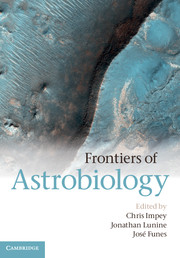Book contents
- Frontmatter
- Contents
- List of contributors
- Part I Introduction
- Part II Origin of Planets and Life
- Part III History of Life on Earth
- 5 The Early Earth
- 6 Evolution of a Habitable Planet
- 7 Our Evolving Planet
- Part IV Habitability of the Solar System
- Part V Exoplanets and Life in the Galaxy
- Index
- Plate Section
- References
5 - The Early Earth
from Part III - History of Life on Earth
Published online by Cambridge University Press: 05 December 2012
- Frontmatter
- Contents
- List of contributors
- Part I Introduction
- Part II Origin of Planets and Life
- Part III History of Life on Earth
- 5 The Early Earth
- 6 Evolution of a Habitable Planet
- 7 Our Evolving Planet
- Part IV Habitability of the Solar System
- Part V Exoplanets and Life in the Galaxy
- Index
- Plate Section
- References
Summary
In this chapter we will look at the environment of the early Earth as a habitat for life and at the primitive life forms that inhabited it. The early Earth was a very different planet from today's Earth. Hotter, much more volcanically active, with an oxygen-poor atmosphere and ocean waters that were probably slightly more acidic and more salty than today's ocean, at first glance the early Earth seems to have been an inhospitable planet. But this was the Earth upon which life first appeared. In fact, life could not have appeared on today's Earth because of the ubiquitous presence of oxygen – an active molecule that effectively destroys the organic ingredients of life by oxidation. Despite its apparent inhospitality, the early Earth was habitable because it had conditions that were conducive to the appearance of simple life forms: it had liquid water, carbon molecules, energy sources, and the elements necessary for both the building bricks of cells and for its metabolic processes (HNOPS, plus transition metals). And this early, different planet apparently teemed with primitive forms of life.
The environment of the early Earth
After consolidation of the planetesimals forming the proto-planet, early radiogenic heat from short-lived radiogenic species, such as 26Al, fused the accreted planetesimals into a molten mass, producing a magma ocean, which allowed differentiation of the heavier elements, iron and nickel, into the core and the lighter elements, forming silicate minerals, into the mantle. Degassing of the early mantle expelled the lighter elements (volatile elements) that were originally contained in the planetesimals to create a weakly reducing atmosphere of N2, CO2, and water, with traces of other gases (Kasting and Brown 1998). About 40 My after the consolidation of the proto-Earth, it was impacted by another smaller planet having a composition not too different from that of the Earth. It is possible to estimate the timing of this impact from the age of differentiation of the cores of the Earth and the Moon. Using the ratio of the quantity of the radiogenic isotope 182H and its daughter 182W remaining in the mantle of the Earth and the Moon, the impact has been dated to approximately between 40 and 100 My after accretion (Yin et al. 2002, Kleine et al. 2009). The planetary material issuing from this glancing impact produced the Earth's satellite, the Moon. The existence of the Moon had a number of consequences.
- Type
- Chapter
- Information
- Frontiers of Astrobiology , pp. 89 - 114Publisher: Cambridge University PressPrint publication year: 2012
References
- 9
- Cited by

